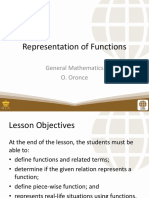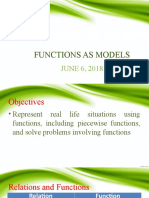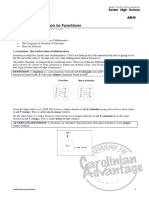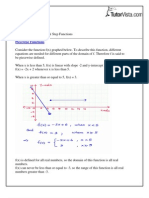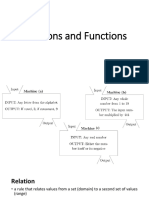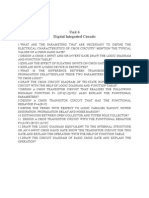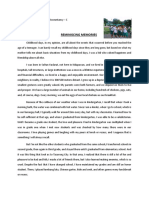Representation of Functions
General Mathematics
Lesson Objectives
At the end of the lesson, the students must be
able to:
• define functions and related terms;
• determine if the given relation represents a
function;
• define piece-wise function; and
• represents real-life situations using functions,
including piece-wise functions.
Relation
A relation is a set of ordered pairs. The domain
of a relation is the set of first coordinates. The
range is the set of second coordinates.
Example of Relations
1. {(1, 4), (2, 5), (3, 6), (4, 8)}
2. {(4, 2), (4, -2), (9, 3), (9,3)}
3. {(1, a), (1, b), (1, c), (1,d)}
Functions
A function is a relation in which each element of
the domain corresponds to exactly one element
of the range.
Examples of Functions
1. {(1, 4), (2, 5), (3, 6), (4, 8)}
2. {(2, 1), (3, 1), (4, 1), (5,1)}
Example 1
Determine if the following relations represent a
function.
1. {(q, 0), (w, 1), (e, 2), (t, 3)}
2. {(-1, -2), (0, -2), (1, -2), (2, -2)}
3. {(1, 0), (1,1), (1, 2), (1, -2)}
4. {(x, 3), (y, 4), (z, 3), (w, 4)}
Some Types of Functions
Linear Function
A function f is a linear function if f(x) = mx + b,
where m and b are real numbers, and m and f(x)
are not both equal to zero.
Quadratic Function
A quadratic function is any equation of the form
f(x) = ax2+ bx + c where a, b, and c are real
numbers and a ≠ 0.
Some Types of Functions
Constant Function
A linear function f is a constant function if
f(x) = mx + b, where m = 0 and b is any real
number. Thus, f(x) = b.
Identity Function
A linear function f is an identity function if f(x) =
mx + b, where m = 1 and b = 0. Thus, f(x) = x.
Some Types of Functions
Absolute Value Function
The function f is an absolute value function if for all
real numbers x,
f(x) = x, for x ≥ 0
–x, for x ≤ 0
Piecewise Function
A piecewise function or a compound function is a
function defined by multiple sub-functions, where
each sub-function applies to a certain interval of the
main function's domain.
Piecewise Function
f(x) = x + 1, if x≥0
–x2+ 1, if x<
0
Example 2
To sell more T-shirts, the class needs to charge a
lower price as indicated in the following table:
The price for which you can sell x printed T-shirts
is called the price function p(x). p(x) represents
each data point in the table.
Solution to Example 2
Step 1:
Find the slope m of the line using the slope formula m = y 2 – y1 / x2 – x1
Step 2:
Write the linear equation with two variables by substituting the values
of m and (x1, y1) to the formula y – y1 = m(x – x1)—the point-slope
form of a linear equation.
y – y1 = m(x – x1)
y – 540 = − (x − 500)
y – 540 = − x + 100
y = − x + 640
y = 640 – 0.2x
Thus, the price function is p(x) = 640 – 0.2x.
Example 3
Find the dimensions of the largest rectangular
garden that can be enclosed by 60 m of fencing.
Solution to Example 3
Let x and y denote the lengths of the sides of the garden. Then
the area A = xy must be given its maximum value.
Express A in terms of a single variable, either x or y. The total
perimeter is 60 meters.
2x + 2y = 60
x + y = 30
y = 30 – x
Hence,
A = xy
A = x(30 – x)
A= 30x – x2
Solution to Example 3
Write this equation in the vertex form by completing the
square.
A = –(x2 – 30x + 225) + 225
A = –(x – 15)2 + 225
The maximum area is 225 square meters.
Since x = 15 (the width) and 30 – x = 15 (the length), the
dimension that gives the maximum area is 15 meters by 15
meters.
Example 4
Sketch the graph of the given piecewise
function. What is f(– 4)? What is f(2)?
f(x) = x + 2, if x≥0
–x2+ 2, if x<
0
Piecewise function
1. A certain chocolate bar costs ₱35.00 per piece. However, if you
buy more than 10 pieces, they will be marked down to a price of
₱32.00 per piece. Use a piecewise function to represent the cost
in terms of the number of chocolate bars bought.
2. A school’s fair committee wants to sell t-shirts
for their school fair. They found a supplier the
sells t-shirts at a price of ₱175.00 a piece but
can charge ₱15,000 for a bulk order of 100
shirts and ₱125.00 for each excess t-shirt after
that. Use a piecewise function to represent the
cost in terms of the number of t-shirts
purchased.
3. A user is charged ₱300 monthly for a
particular mobile plan, which includes 100 free
text messages. Messages in excess of 100 are
charged 1 each. Represent the amount a
consumer pays each month as a function of the
number of messages sent in a month.
2
Solution to Example 4
To find the value of the function when x = – 4,
use the second equation.
f(– 4) = – (– 4)2+ 2 = – 16 + 2 = – 14
To find the value of the function when x = 2, use
the first equation.
f(2) = 2 + 2 = 4
Exercise A
Determine whether or not each relation is a
function. Give the domain and range of each
relation.
1. {(2, 3), (4, 5), (6, 6)}
2. {(5, 1), (5, 2), (5, 3)}
3. {(6, 7), (6, 8), (7, 7), (7, 8)}
Exercise B
Tell whether the function described in each of the
following is a linear function, a constant function,
an identity function, an absolute value function,
quadratic function or a piecewise function.
1. f(x) = 3x − 7
2. g(x) = 12 4.
3. f(x) = 3x, if x > −5 5.
-6x, if x < −5
Exercise c
Tell whether thefollowing is a function or not.
1. 2.
Exercise C
A zumba instructor charges according to the number
of participants. If there are 15 participants or below,
the instructor charges ₱500.00 for each participant
per month. If the number of participants is between
15 and 30, he charges ₱400.00 for each participant
per month. If there are 30 participants or more, he
charges ₱350.00 for each participant per month.
1. Write the piecewise function that describes what
the instructor charges.




